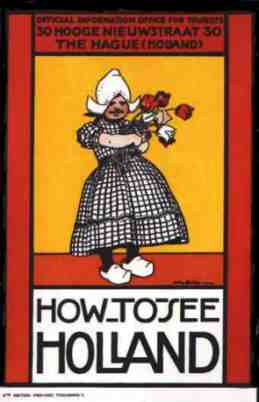
1923>
How to see Holland
The Dutch artist Willy Sluiter was invited to design this beautiful brochure for the KLM and the 'Algemene Vereeniging voor Vreemdelingenverkeer' (The Dutch National tourist Association)
Sluiter used traditional images of Holland for the brochure: a girl carrying a bunch of tulips, wearing the traditional costume of the Dutch fishing village of Volendam.
This other advertisement uses the phrase 'bliksemsnel' (fast as lightning): it is doubtful whether the literal depiction of themes as these inspired confidence in the traveller.
First winterservices
In 1923 KLM flew summer and... winter. The full year services were applied with regularity and security that the Dutch aviation would give his excellent reputation abroad. For these services the KLM used Fokkers F.II and F.III. During the summermonths the serviceregularity reached 100%! "Safety first" was the KLM slogan. Beside safety, luck also was involved. Personal accidents dit not occur in this year. No wonder KLM got a name in reliability and regularity. But that did not mean that accidents dit not happen. In fact, in 1923, an emergency landing was made by the H-NABH (a Fokker F-III with captain Iwan Smirnoff in charge) |
on a sandbank in the North sea. Read more
about Fortunately events like this were rare. |
How New Fokker F.V.
On 1 May 1922 the new Fokker F.V was entered in Fokker's name in the Dutch register of aircraft. A year later in March 1923, the Comité Vliegtocht Nederland-Indië - the Netherlands-Indies Flying Expedition Committee - became interested in the F.V. The committee wanted to work towards achieving the first flight to the Dutch East Indies colony, now known as Indonesia. Such a flight would open the way for a future scheduled service to the Indies to be operated by KLM. The journey time by aircraft would be considerably less than by ship. To stimulate the pioneering spirit the Dutch East Indies government, as early as October 1919, had put up 10,000 Dutch guilders as prize money for whoever would complete such a flight within 14 days. The Indies' government was not very knowledgeable about flying or they would have realized that this was an inadequate sum and that to fly to the Indies within 14 days was technically impossible at that time. After an article in the magazine 'De Auto entitled "Amsterdam Batavia by airplane" had explained these problems, |
|
the prize money was raised to 50,000 guilders and the permitted travel time to one month. This aroused interest especially in military circles. In October 1923. No such flight took place and in any case Fokker, who was a member of the Comité, had to admit that the aircraft was not suitable for this enormous journey. |










